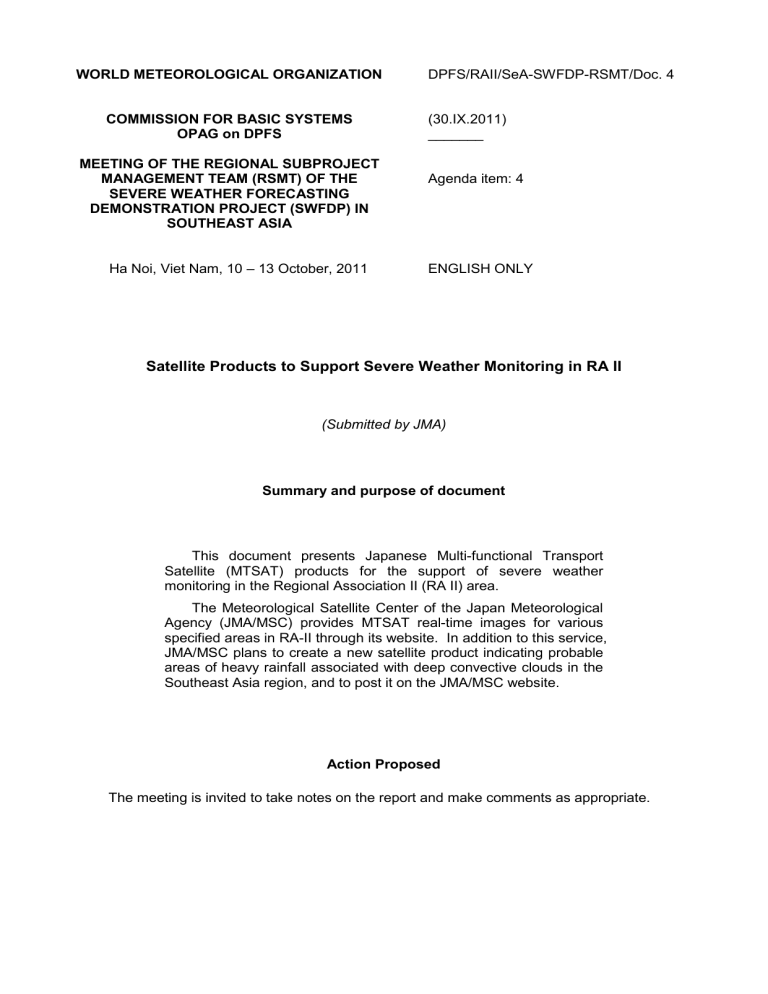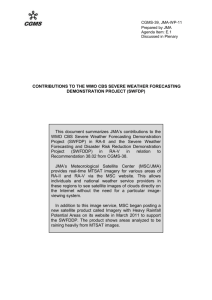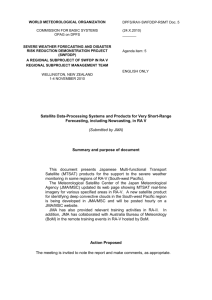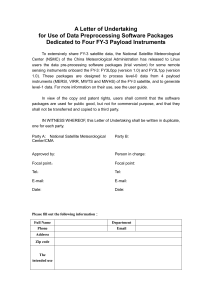Satellite data-processing systems and products for very short

WORLD METEOROLOGICAL ORGANIZATION
COMMISSION FOR BASIC SYSTEMS
OPAG on DPFS
MEETING OF THE REGIONAL SUBPROJECT
MANAGEMENT TEAM (RSMT) OF THE
SEVERE WEATHER FORECASTING
DEMONSTRATION PROJECT (SWFDP) IN
SOUTHEAST ASIA
Ha Noi, Viet Nam, 10 – 13 October, 2011
DPFS/RAII/SeA-SWFDP-RSMT/Doc. 4
(30.IX.2011)
_______
Agenda item: 4
ENGLISH ONLY
Satellite Products to Support Severe Weather Monitoring in RA II
(Submitted by JMA)
Summary and purpose of document
This document presents Japanese Multi-functional Transport
Satellite (MTSAT) products for the support of severe weather monitoring in the Regional Association II (RA II) area.
The Meteorological Satellite Center of the Japan Meteorological
Agency (JMA/MSC) provides MTSAT real-time images for various specified areas in RA-II through its website. In addition to this service,
JMA/MSC plans to create a new satellite product indicating probable areas of heavy rainfall associated with deep convective clouds in the
Southeast Asia region, and to post it on the JMA/MSC website.
Action Proposed
The meeting is invited to take notes on the report and make comments as appropriate.
DPFS/RAII/SeA-SWFDP-RSMT/Doc. 4, p. 2
1. Introduction
The Japan Meteorological Agency (JMA) has operated geostationary meteorological satellites for more than 30 years and delivers satellite images of clouds to users in the East Asia and West Pacific regions, including member countries in Regional Association II (RA II). In order to improve accessibility to this data, JMA’s Meteorological Satellite Center (MSC) provides MTSAT real-time images clipped for various areas through its website. In addition to this service, the
Center plans to create and provide a new satellite product for the support of severe weather monitoring in the Southwest Asia region.
2. MTSAT Real-Time Imagery over the Internet
JMA/MSC has set up a web page at http://mscweb.kishou.go.jp/sat_dat/img/reg/sat_img.htm
presenting MTSAT real-time images for various specified areas, as shown in Figure 1. The page makes it easy for National Meteorological and Hydrological Services (NMHSs) to obtain satellite images of clouds via the Internet.
Images of 15 areas are currently provided. For the Southeast Asia region
(including Cambodia, Lao PDR, Thailand and Viet Nam), the following four areas are covered:
Southeast Asia 1
(80 °E, 30°N – 115°E, 0)
Southeast Asia 2
(105 °E, 30°N – 140°E, 0)
Southeast Asia 3
(90 °E, 10°N – 145°E, 15°S)
High-Resolution Asia 1
(99 °E, 16°N – 110°E, 8°N)
The web page shows satellite images taken over the past 24 hours from four MTSAT channels: the visible band (0.73 μm), the infrared band in the atmospheric window (11 μm), the water vapor absorption band (6.7 μm) and the nearinfrared band (3.8 μm). The series of images can be displayed as an animation.
MSC will provide additional image sectors in line with user requirements.
Figure 1. MTSAT real-time imagery on the MSC website
3. Imagery with Heavy Rainfall Potential Areas
JMA/MSC is planning to provide a new satellite product as shown in Figure 2 for the support of severe weather monitoring in the Southeast Asia region. The new product, called Imagery with
Heavy Rainfall Potential Areas, provides information on areas (hereafter referred to as “potential
DPFS/RAII/SeA-SWFDP-RSMT/Doc. 4, p. 3 area s”) that may experience heavy rainfall associated with deep convective clouds. JMA will create this product based on a similar one that has been provided since March 2011 by JMA/MSC for the
Southwest Pacific region as a contribution to the Severe Weather Forecasting and Disaster Risk
Reduction Demonstration Project (SWFDDP) in RA V. For reference, the product for RA V can be seen on the MSC website at http://mscweb.kishou.go.jp/RA-V/sat_img.htm
.
30 °N
20
°N
10 °N
0 °N
90 °E 100 °E 110 °E 120 °E
Figure 2. A sample of Imagery with Heavy Rainfall Potential Areas
The product comes in image form and complies with the specifications of the JPEG format.
The coverage will be from 30 °N to 0°N and from 90°E to 120°E, and the area can be adjusted or divided into several smaller sectors in line with user requirements. The spatial resolution of each pixel is 0.05 degrees in both latitude and longitude.
Potential areas of heavy rainfall are shaded in magenta. Comparison with the Global Satellite
Mapping of Precipitation (GSMaP*) product shows that the potential areas cover about 79% of rainfall zones with a rainfall rate of more than 20 mm/h in RA V.
The basic algorithm for identifying deep convective clouds with heavy rainfall involves the following considerations: t he brightness temperature of 6.7 μm (T6.7) is lower than that of 10.8 μm
(T11) and that of 12.0 μm (T12) when clouds are in the development stage and their tops do not reach the tropopause; T6.7, T11 and T12 are almost identical when convective cloud tops reach the tropopause; T6.7 may be higher than T11 when cloud tops overshoot into the stratosphere; and the temperature difference between T11 and T12 increases when thin cirrus clouds are observed.
It should be noted that potential areas indicate only the probability or possibility of heavy rainfall, as MTSAT has no function to measure rainfall itself. Potential areas identified using this algorithm do not always match areas of actual heavy rainfall because shallow convective clouds may remain undetected, clouds smaller than the spatial resolution of satellite observations (4 km at the sub-satellite point) may not be seen, and dense cirrus may be misclassified as deep convective clouds.
DPFS/RAII/SeA-SWFDP-RSMT/Doc. 4, p. 4
* The GSMaP Project is sponsored by JST-CREST and promoted by the JAXA Precipitation Measuring
Mission (PMM) Science Team. GSMaP products are distributed by the Earth Observation Research Center of the Japan Aerospace Exploration Agency. ( http://sharaku.eorc.jaxa.jp/GSMaP_crest/index.html
)
4. Related Activities by JMA
(1) Training
JM A’s VRL website
Since 2002, JMA has provided the Virtual Resource Library (VRL) on MSC’s website at http://mscweb.kishou.go.jp/VRL/index.htm
as a contribution to the Virtual Laboratory for Education and Training in Satellite Meteorology (VL) of the Coordination Group for Meteorological Satellites
(CGMS). The resources posted include the following titles:
- Outline of meteorological observation by satellites and its applications
- Introduction to remote sensing
- Objective cloud analysis
- Microwave remote sensing
The SATAID (Satellite Animation and Interactive Diagnosis) software program is also available on the website. The program is developed for analysis and interpretation of satellite images, and is designed to enable the handling of ancillary data such as grid point values from numerical weather prediction (NWP) data. Details of satellite image provision are also outlined on the website at http://www.jma.go.jp/jma/jma-eng/satellite/ds.html
.
Remote training with the Australian Bureau of Meteorology
JMA has collaborated with the Australian Bureau of Meteorology (BoM) on remote training events in RA-V hosted by BoM, providing two remote training sessions on the Advanced
Forecaster Course entitled Imagery of the 3.8-micron Channel in 2009 and Objective Cloud
Analysis in 2010.
Other activities
JMA runs group training courses in meteorology with the Japan International Cooperation
Agency (JICA) covering satellite meteorology, numerical weather prediction and climate information. The Agency has hosted more than 260 meteorologists from National Meteorological
Hydrological Services since 1973 for such training, which involves lectures and exercises for analysis and interpretation of satellite data. Some of the training materials used are provided on the VRL website.
(2) RA-II Pilot Project for satellite data utilization
JMA promotes the RA-II Pilot Project to develop support for NMHSs relating to satellite data, products and training in RA-II in coordination with the Korea Meteorological Administration (KMA).
The project was established as a kind of self-help effort for NMHSs in RA II to improve the flow of satellite-related information. The major focus of the initiative is to facilitate the timely provision of satellite-related information by satellite operators themselves to users (i.e., NMHSs in RA II), and particularly those in developing nations, including least developed countries (LDCs).
Accomplishments
The accomplishments of the RA II Pilot Project’s first phase from September 2009 to August
2010 and its second phase from September 2010 to August 2011 can be summarized as follows:
- Issuance of quarterly newsletters to RA II Members
DPFS/RAII/SeA-SWFDP-RSMT/Doc. 4, p. 5
- Establishment of RA II Pilot Project web pages on the WMO Space Programme (WMOSP) website hosted by WMOSP
- Creation of RA II Member and Coordinating Group Member mailing lists
- Alignment of Pilot Project activities and Virtual Lab activities to optimize assistance to
NMHSs in RA II
- Identification of RA II Member requirements
Action plan
The action plan of the RA II Pilot Project’s third phase from September 2011 to August 2012 can be summarized as follows:
- Issuance of quarterly newsletters to RA II Members
- Enhancement of Pilot Project web pages on the WMO Space Programme (WMOSP) website hosted by WMOSP
- Enhancement of RA II Member and Coordinating Group Member mailing lists (by April 2012)
- Identification of RA II Member requirements (by April 2012)
- Alignment of Pilot Project activities and Virtual Laboratory activities to optimize assistance to
NMHSS in RA II (by August 2011)
- Planning of the 2nd Meeting of the Coordinating Group of the RA II Pilot Project to be held in
2012
- Creation of the fourth-phase working plan (by August 2012)
5. Conclusion
JMA/MSC will provide additional satellite products to support severe weather monitoring in the Southeast Asia region as a contribution to the SWFDP in RA II. Project members are invited to take advantage of these products as described above and to communicate with satellite operators to provide further information and clarify requirements in relation to additional satellite products.






